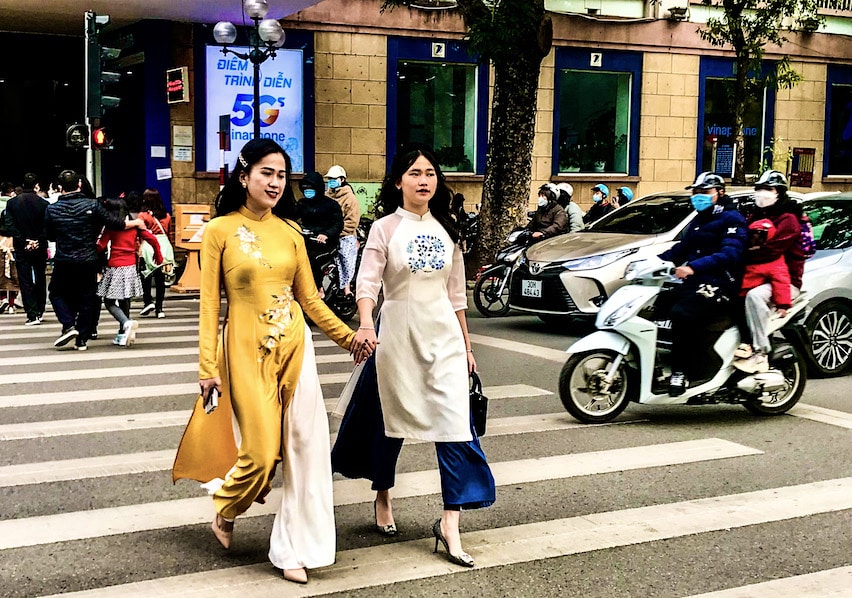
Two young women wearing stylish ao dai cross Hanoi’s Dinh Tien street. When the Vietnam war ended in 1975, the ao dai was viewed with suspicion in the communist north. Today, however, it is embraced as a national costume, not as a remnant of French colonialism. Photo by John Anderson.
By John Gottberg Anderson
What images come to mind when you think of Vietnam? A peasant in the conical nón lá hat, harvesting rice from the fields? Colorful lanterns dancing from the masts of river boats or the corrugated eaves of Taoist temples in ancient Hoi An? Perhaps you dream of karst peaks that erupt from the placid waters of deep-blue Ha Long Bay?
All are part of the visual culture of the country I now call home. But I believe nothing says “Vietnam” more than the áo dài. The sleek silk gown is as much a statement of Vietnamese fashion and femininity as is the kimono in Japan, the sari in India or the cheongsam in China.
At once draping and clinging, accenting the Asian woman’s natural curves, the áo dài teases with restraint and decorum, promising nothing but implying everything. As worn by Vietnamese women, who learn to walk gracefully at a young age, it is at once marvelously modest yet incredibly provocative. A man who isn’t stirred is either dead or recently divorced.
Pronounced “ow yai” in Vietnam’s south, “ow zhai” in Hanoi and the north, the simply designed garment has two parts. A long, tailored silk tunic, extending from shoulders to shoes, is split at the waist. Don’t go looking for leg: Beneath the tunic are loose silk pants, either of the same color or a contrasting hue.
The áo dài is typically worn with stylish heels. As the woman walks, the tunic and pants seem to flow, intimating a gentle rhythm. I doubt that any fabric but silk would create this same effect. The step is hypnotic. It’s playful, mischievous, a little suggestive. It teases with each stride, seeming to say, “I’m a good girl … until you get to know me.”
Special occasions
At the annual Ao Dai Festival, which takes place over six weeks in March and April in Ho Chi Minh City (Saigon), Vietnam visitors can see the silk gown in various exhibitions, parades, art performances and competitions. There’s a permanent Áo Dài Museum on a lovely river islet in Saigon’s District 9, as well as a smaller second-floor exhibit on Dong Khoi street in the heart of District 1. Docents at major museums in the largest cities, including Independence Palace in Ho Chi Minh City and the Vietnam Museum of Ethnology in Hanoi, inevitably wear áo dài. Likewise, in historic, tourism-dependent towns such as Hoi An, 25 miles from Da Nang, and Hué, the ancient imperial capital, áo dài are de rigueur at visitor attractions.
Beyond these, the áo dài is not everyday attire in modern Vietnam. It is normally worn only for special occasions — such as weddings and graduations — as well as the Tết (Vietnamese new year) festival in late January or early February. Women wear their best áo dài during Tết when they pay tribute to ancestors at temples and shrines, and to visit family and friends whom they may see only once a year.
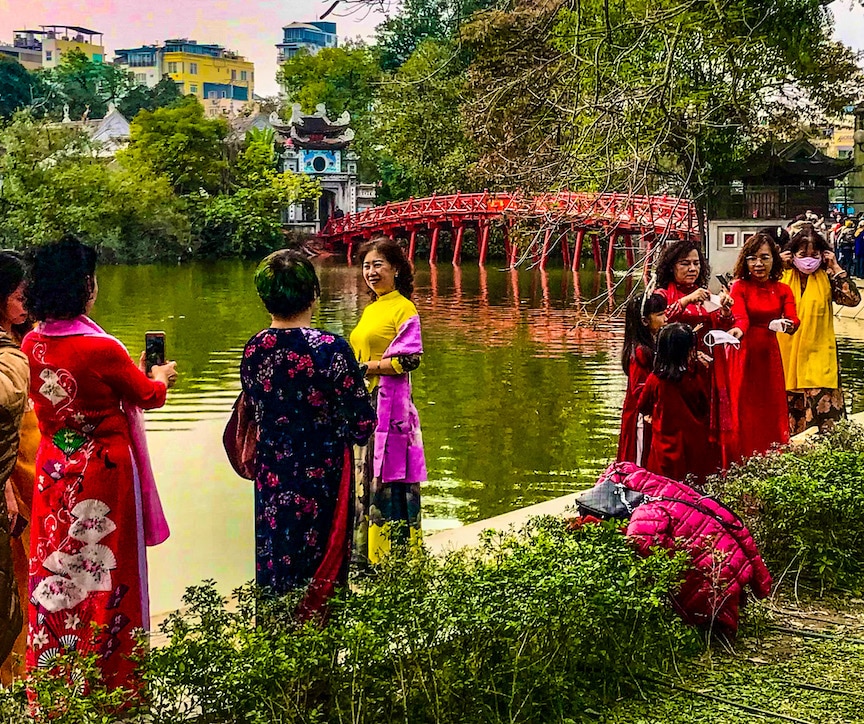
Vietnamese women celebrating Tet in Hanoi gather on the northeastern shore of Hanoi’s Hoan Kiem Lake beside the footbridge that crosses over to Ngoc Son temple. Their photos will help them remember the celebrations coinciding with the incoming Year of the Tiger. Photo by John Anderson
At weddings, brides and grooms often choose áo dài heavy with colorful brocade embroidery — most often red, symbolizing luck and prosperity. The man’s garb ís typically a thick brocade robe called áo gấm. The wedding entourage will choose their own elaborate áo dài, while guests will wear simpler but similarly colorful designs.
Importance of Color
Each color has a meaning. Gold, for instance, was a royal color for kings and queens. White represents purity and innocence (one woman told me she will choose something simple and all white for her nuptials); black is most often worn at funerals.
Many high schools and universities request that women teachers wear áo dài on a daily basis, and female students are often asked to wear traditional white gowns at least once a week. Mistresses of ceremonies (“emcees”) wear colorful áo dài at nearly every event they officiate. Beauty pageants, starting with the annual Miss Universe Vietnam contest in June, are cavalcades of áo dài fashion.
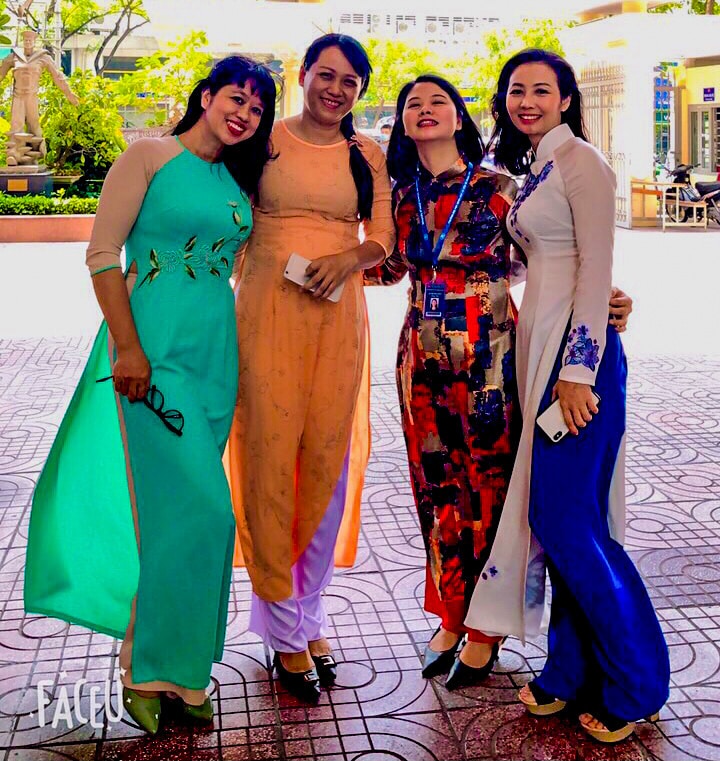
Teachers at Vietnam National University of Social Sciences and Humanities in Ho Chi Minh City (Saigon).
Style and design
Styles, which are constantly evolving, vary widely according to occasion and designer. One innovation is the widening of a panel on both sides of the waist, exposing midriff skin and making the garment even more sensuous than it was. Contemporary fashion designers envision relaxed and creative looks, including short sleeves and knee-length styles for wearing on motorcycles and bicycles. Wide-collared “boat necks” are at once casual and elegant. Although tradition dictates sophistication in formal settings, the more practical adaptations are bringing new life to an old classic.
“We can always find new, creative designs, depending upon the event we’re attending,” says professional emcee Tracy Thủy Hoàng, who has a closetful of the distinctive dresses. “It’s up to us. I have mine made especially for me. Some people might buy one in the market, but I think the áo dài might not have the right fit, then it would not be beautiful. It’s better to get a tailor!”
In recent decades, fashion designer Le Sĩ Hoàng has become known for his hand-painted áo dài designs, adorning the silk fabric with visions of nature or abstract design, turning it into a living piece of art, becoming one with the wearer.
Another popular contemporary designer, Đặng Thị Minh Hạnh, specializes in hybridizing traditional designs with modern clothing. She embellishes áo dài with boldly embroidered brocade, the motifs often reflecting cultural traditions of the nation’s many ethnic minorities.
The roots of fashion
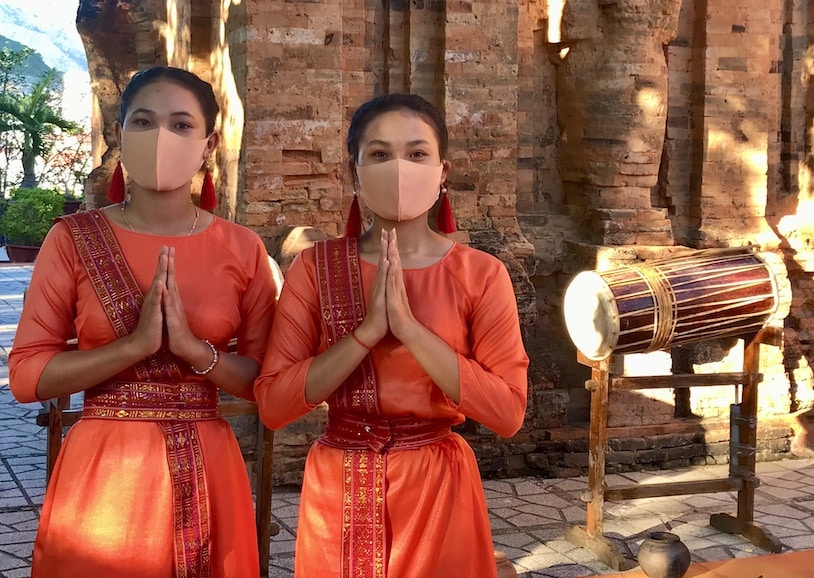
Cham women in traditional ao dai perform a dance beside a restored Cham temple in Nha Trang. Cham villages can be found in Dong Nai, Binh Thuan, Ninh Thuan, Khanh Hoa, Binh Dinh and Quang Nam provinces, and the ethnic group’s artistic magic is on display at the Museum of Cham Sculpture in Da Nang. Photo by John Anderson.
The earliest áo dài were far from beautiful. Designed for functionality, they were loose and baggy, plain in appearance and hardly form-fitting. Fashion historians have traced the style’s origins to the ancient Champa Empire, a Hindu realm of the 2nd to 17th centuries that stretched down much of the central Vietnam coast. Cham women were known for their long, colorful dresses of lacy chiffon. The warlord Nguyễn Phuc Khoat, having conquered southern Champa, sought a separate cultural identity from the rival Trinh lords of northern Vietnam. Inspired by the gowns of the vanquished (whose support he sought), he ordered a unique outfit, a long gown over trousers, for his courtiers. He called it áo dài.
In the north, working-class women wore an áo tu than, a “four-panel tunic.” The outer tunic was in four sections, two in back sewn together, two in front left open and tied with a belt around the waist. Within the tunic, the woman wore a bodice undergarment over her chest and a long skirt to cover her legs.
French colonists arrived in the mid-19th century and stayed in Vietnam for a century. These Europeans left behind many things, from baguette sandwiches (bánh mì) and beef noodle soup (phở) to modern city planning, oil painting and brassieres. They also introduced a new fashion consciousness.
Sometime around 1930, a group of French-trained student artists from the Indochinese Fine Arts University in Hanoi turned their attention from canvas to fabric. Led by tall, handsome Nguyễn Cát Tường (“Le Mur”) — his nickname, French for “The Wall,” was a translation of his Vietnamese name, Tường — they applied their education in European style to the utilitarian lines of the traditional áo dài. Rather than hiding the feminine shape, Le Mur’s group envisioned a sleeker, form-fitting áo dài that would be sensual and elegant.
Starting with the áo ngu than (five-panel gown), the young designers incorporated their awareness of contemporary French fashion. They flared the tight sleeves, reinvented the collar, gave the pants a higher waistline. Some criticized the design as too European — but Le Mur’s generation went to French schools, learned the French language and studied French literature. They were not so much influenced by Chinese culture as by the West.
A Designer Disappears
When Le Mur introduced the concept in 1934, it made a nationwide splash. By the late 1930s, Nam Phuong, the last empress of Vietnam, was proudly wearing this new áo dài as a sort of national costume. She looked so chic that painters and sculptors began to model their subjects (even including the Virgin Mary) in áo dài. Indeed, the garment came to embody class and sophistication for Vietnamese women, and it started a fashion craze.
Le Mur continued to introduce fresh designs for many years. Indeed, he became an honored figure throughout Asia. But his association with French culture led to his demise. After the August Revolution of 1945, which climaxed in the Communist party’s declaration of Vietnamese independence from France, Japan and imperial Vietnam, Le Mur, 35, was captured by the Viet Minh, sent to a reeducation camp and never heard from again.
The test of time
Not surprisingly, it was in the republican South rather than the communist North where the modern áo dài withstood the test of time. In particular, Trần Lệ Xuân, also known as Madame Nhu, the de facto first lady of South Vietnam from 1955 to 1963 and an often-controversial champion of women’s rights, was well-known for wearing a décolleté áo dài to formal functions.
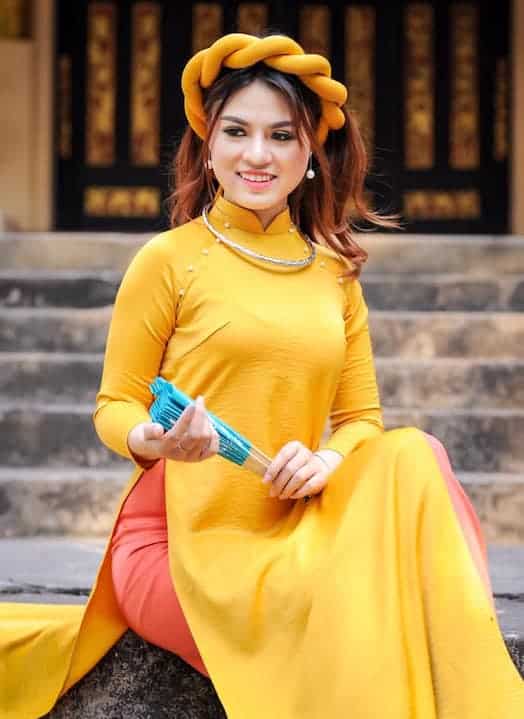
Vietnamese woman in ao dai. The color gold was once considered appropriate only for kings and queens. Photo courtesy Lam Nhi.
Ironically, Nguyễn Thi Binh, later a vice president of Vietnam, wore an áo dài as a Viet Cong negotiator at the Paris Peace Conference of 1973 to demonstrate her patriotism — even though the communist government had declared it a symbol of “capitalist decadence.” Some praised her; others felt her choice of dress was in poor taste. Indeed, Ho Chi Minh himself had written in a 1947 essay that because the áo dài was not an appropriate garment for either field or factory, it should be worn only for special occasions or unique public appearances.
As a child growing up in Vietnam in the 1950s and ‘60s, author Le Ly Hayslip, author of When Heaven and Earth Changed Places and Child of War, Woman of Peace, remembers there was a law requiring women to fully cover their bodies, especially when bending in a market or other outdoor venue. “The older, loose-fitting áo dài predecessor was preferred,” she recalls, “especially when the communist government banned the more modern dress which it thought represented Saigon’s deference to Western style.”
When Hayslip — today a philanthropist who directs the Global Village Foundation— returned to Vietnam in the late 1980s, she saw “women working in offices, hotels and restaurants, wearing only old white shirts and black pants, like farmers in the countryside. Women could only buy so many yards of material to clothe their whole family each year, so most people were wearing old rags.”
Elegance Restored
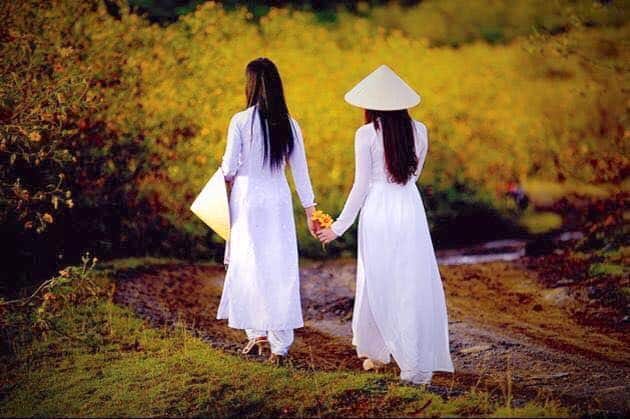
Young Vietnamese sisters wear white ao dai, symbolizing purity and innocence, as they follow a rural path in Lam Dong province. Photo courtesy Lam Nhi.
Times have certainly changed. As a free-market economy grew and developed in the communist country, and Vietnam reopened to international tourism in the 1990s, the áo dài regained nationwide recognition. Indeed, the áo dài found itself a key element in broadcasting Vietnam’s photogenic appeal to visitors from around the world.
Today, the image of beautiful and self-confident women strolling through the urban marketplace or past a rural rice field has become an integral part of Vietnam’s marketing plan. Even the uniforms of flight attendants on Vietnam Airlines and budget competitor Bamboo Airways are stylish áo dài.
There’s little doubt that the future will continue to see new innovations and elegance in the evolution of this classic of Asian fashion.![]()
Journalist John Gottberg Anderson is based in Ho Chi Mink City. His last story for EWNS was a review of John Burgess’ book on Angkor’s Temples in the Modern Era.

